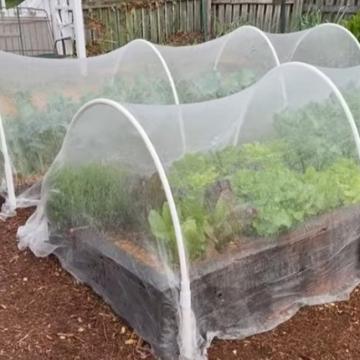Leafy greens such as lettuce, spinach, and kale are highly susceptible to pest damage, often targeted by insects like aphids, caterpillars, and flea beetles. One effective and chemical-free method of protecting these crops is the use of insect netting. Insect netting provides a physical barrier that prevents pests from reaching your plants while allowing light, air, and water to penetrate. This method is particularly beneficial for leafy greens that do not require pollination.
Benefits of Using Insect Netting
- Chemical-Free Protection: Insect netting eliminates the need for pesticides, making it an eco-friendly option for organic gardeners and those looking to avoid chemicals.
- Preventing Insect Infestation: By creating a physical barrier, netting blocks common pests like aphids, cabbage worms, and flea beetles from accessing your plants.
- Improved Plant Health: Without the stress of pest damage, your leafy greens are more likely to thrive, producing healthier and more robust crops.
- Extended Growing Season: Insect netting can also protect plants from extreme weather conditions, including heavy rain and strong winds, which can otherwise damage tender leaves.
Methods of Installing Insect Netting
There are two main approaches to using insect netting in your garden: floating row covers and constructing frames from PVC tubing. Both methods offer flexibility and can be customized to suit the size and layout of your garden.
- Floating Row Covers
- What It Is: Floating row covers involve laying insect netting directly over the crops without any supporting structure. The netting is secured to the ground around the edges, using soil, rocks, or garden staples.
- How It Works: The netting "floats" above the plants, allowing them to grow naturally without being restricted. As the plants grow, the netting adjusts, providing continuous protection.
- When to Use: This method is ideal for smaller gardens or raised beds, where the netting can be easily adjusted as needed.
- Pros and Cons: Floating row covers are easy to set up and require minimal materials, making them a cost-effective option. However, taller plants may push against the netting, requiring occasional adjustments.
- Constructing a Frame from PVC Tubing
- What It Is: This method involves creating a more permanent structure using PVC tubing to form hoops or frames over your garden beds. The insect netting is then draped over the frame and secured to the ground.
- How It Works: The PVC tubing is bent into arches and inserted into the ground on either side of the garden bed, creating a tunnel-like structure. The insect netting is placed over the frame and fastened securely at the base to prevent pests from getting inside.
- When to Use: This approach is ideal for larger garden areas or when you need a more durable solution that can withstand wind and weather.
- Pros and Cons: PVC frames provide better support for taller plants and allow you to easily access your crops for maintenance and harvesting. However, this method requires more materials and time to set up compared to floating row covers.
Tips for Success
- Choose the Right Netting: Insect netting comes in various mesh sizes. Choose a fine mesh that effectively blocks smaller pests like aphids while still allowing sufficient airflow and light.
- Secure the Edges: Ensure that the netting is securely fastened to the ground on all sides to prevent pests from crawling underneath. Garden staples, rocks, or soil can be used to hold the netting in place.
- Monitor Plant Growth: Check your plants regularly to ensure that the netting is not restricting their growth. Adjust the netting or frame as needed to accommodate expanding crops.
- Remove Netting for Maintenance: Although insect netting provides excellent protection, it’s essential to periodically remove it to check for any trapped pests or weeds that may have developed underneath.
Here is a short video I created on a system I set up and how successful it has been.
Insect netting offers an effective, chemical-free way to protect your leafy green crops from pests, promoting healthier plants and higher yields. Whether you choose to use floating row covers or construct a frame from PVC tubing, this versatile solution can be adapted to your garden’s needs. By incorporating insect netting into your gardening routine, you can reduce pest damage and enjoy bountiful harvests of fresh, leafy greens throughout the growing season.

